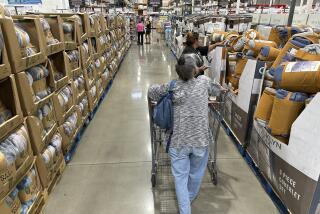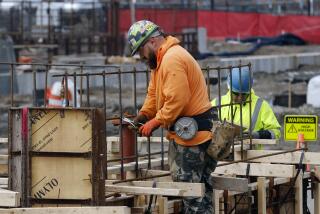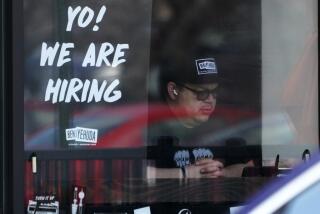Businesses’ Big-Ticket Purchases Raise Hopes
- Share via
Early next month, Clarke Engineering Inc. will make room on its North Hollywood plant floor for its biggest investment ever: an $800,000 gear-grinding machine from Italy.
The Samputensili S-375-G will allow the company to make a host of new high-precision gears for customers in aerospace and other industries, says Lee Mason, Clarke’s vice president.
The decision to spend that money wasn’t easy, she said. Although the company is 50 years old, it’s still relatively small, with just 10 employees.
“It’s a large chunk for us,” Mason said of the investment. But with the economy improving, and its customers’ confidence rising, Clarke saw a need to stay competitive by adding the state-of-the-art machine, she said.
Clarke’s big purchase is part of a trend that has picked up steam over the last year nationwide. More firms are boosting spending on updated equipment and are giving the green light to expansion projects.
The continuing surge in so-called capital spending by businesses is raising hopes that it will bolster U.S. economic growth this year and in 2006. The timing couldn’t be better because high oil prices and rising interest rates could cause a retrenchment by American consumers, whose spending has largely carried the economy in this decade.
What’s more, companies’ willingness to open their wallets wider for new equipment, buildings and software should eventually translate into significant job growth, some analysts say. That would end a relatively paltry period of employment gains since 2002, as many executives have balked at adding staff.
“There tends to be a strong correlation between capital spending and employment” in the long run, said John Lonski, an economist at Moody’s Investors Service in New York.
Optimism about the potential follow-on effects of corporate America’s spending has risen in recent months, as government data have shown an acceleration in business outlays.
In the fourth quarter of 2004, U.S. business fixed investment -- a key measure of capital spending -- rose at a 14% annualized rate from the third quarter, according to the Commerce Department. That was up from a 13% jump in the third quarter and a 12.5% increase in the second quarter.
The dollar value of that spending in the fourth quarter was an annualized $1.28 trillion, surpassing the previous peak of $1.25 trillion in the fourth quarter of 2000, just before the economy fell into recession and corporate investment plummeted.
The Business Roundtable, an association of the nation’s largest companies, said this month that its latest survey of chief executives showed that 60% expected to increase capital spending in the next six months. That was up from the 50% of CEOs who projected higher capital spending in a December survey.
“It feels pretty enthusiastic out there,” said James Gelly, chief financial officer at Milwaukee-based Rockwell Automation Inc., which makes industrial automation equipment. The company’s sales leapt 20% in the fourth quarter, to nearly $1.2 billion, as more businesses spent money on its Allen-Bradley division machine controls, Reliance Electric motors and other gear.
Gelly said the company was finding that more of the orders it was receiving were for plant or product-line expansions, rather than just the replacement of outdated equipment to maintain current production.
Many old-line U.S. manufacturers are discovering that the appetite for their products has never been greater, Gelly said. The dollar’s long slide since 2002 has made American manufacturers far more competitive with many foreign rivals. And fast-growing economies such as China and India are stoking demand for goods from America’s Midwest industrial belt and from other manufacturing centers, including greater Los Angeles.
For a growing number of companies, “There’s suddenly a moment of clarity, that supply isn’t rising as fast as demand,” Gelly said.
Business investment also can feed on itself, because companies may fear losing customers if they don’t match rivals’ modernization moves, experts say.
There was more evidence last month that the trend in capital spending was continuing to improve: The government reported a surprising increase in January business orders for durable goods -- equipment expected to last at least three years.
Excluding aircraft and defense-related equipment, orders for durable goods rose a strong 2.9% in January. Economists had expected the gain to be much smaller, in part because a federal tax incentive for business spending expired in December.
The fourth-quarter business spending data, and the January jump in demand for durable goods, encouraged some analysts to sharply raise their estimates of U.S. economic growth in the current quarter.
David Rosenberg, chief North American economist at brokerage Merrill Lynch & Co. in New York, lifted his estimate of real, or inflation-adjusted, first-quarter gross domestic product growth to an annualized rate of 4.3%, from 3.2%.
Recent data “pretty well bake in the cake another double-digit quarter for business spending,” Rosenberg said.
If he’s right, it would mark the first time since 1997 that capital spending has posted double-digit increases for four consecutive quarters.
At International Rectifier Corp. in El Segundo, Chief Executive Alex Lidow said he expected to maintain capital spending at a rate equal to 10% of the company’s total sales in the near future.
International Rectifier makes semiconductors that conserve and manage power use in computers, hybrid cars, industrial equipment and other machinery. Demand has been exploding worldwide for the company’s products, particularly in China and India, Lidow said.
The firm is spending to add new products and to upgrade its manufacturing capabilities, such as to handle more and larger silicon wafers, the discs from which semiconductors are cut, he said.
Lidow believes that in the semiconductor industry overall, “Capital spending has been too low in the last five years. There’s a chronic underinvestment going on” in the business, he said, which he believes could lead to shortages if the industry doesn’t pick up the spending pace.
Some corporate critics say that even if capital spending in general keeps rising, it won’t translate into a healthier U.S. economy in the long run if employment doesn’t grow as well.
Although corporate earnings have rebounded since 2002 to record levels and many businesses are sitting on massive piles of cash, the continuing focus on efficiency favors investment in machines, but not necessarily in workers, economists say.
Lonski, the economist, said the last two years had been unusual in that job growth historically has much more closely tracked rising capital spending.
This time, he said, employment may have lagged in part because much of the initial capital spending may have replaced obsolete equipment with new machines that were more efficient, but that didn’t require more workers -- and may even have required fewer.
If more companies now are moving into a phase in which capital spending is funding expansion, such as new product lines or a sharp increase in production, that should lead to more hiring, Lonski and others say.
The government’s report this month that employment rose by a net 262,000 jobs in February, the most since October, was a hopeful sign, Lonski said.
Rockwell’s Gelly said product-line expansions could require more than just additional manufacturing workers. People also may be needed to design, sell and service new goods, he said.
In many industries, “It ain’t hamburger-flipping jobs we’re going to need” if capital spending continues to rise, Gelly said.
But some experts say the globalization of the economy may mean that domestic hiring will continue to lag, despite robust capital spending.
Many companies will be reinvesting profit overseas, which is where they may have made the money to begin with via outsourcing, said Michael Bazdarich, a senior economist at the UCLA Anderson Forecast.
Still, he said, a sustained high level of business spending will be crucial to keeping the U.S. economy expanding this year, if consumer spending slows.
“What growth there’s going to be this year,” Bazdarich said, “will be from exports and capital spending.”
More to Read
Inside the business of entertainment
The Wide Shot brings you news, analysis and insights on everything from streaming wars to production — and what it all means for the future.
You may occasionally receive promotional content from the Los Angeles Times.










